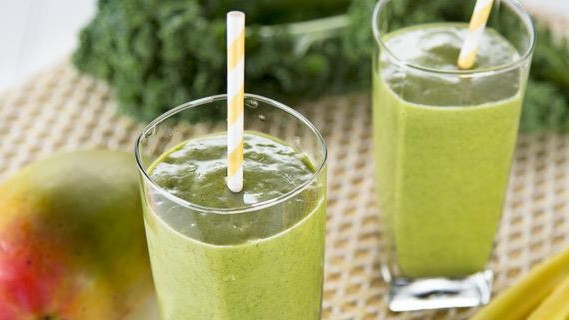Pineapple Mango Smoothie Recipe

Mornings are a little easier when there’s something delicious to look forward to after waking up. Make your breakfast a healthy one to anticipate!
The choices you make at the beginning of the day are a good indicator of how you’ll feel for the rest of the day. If you skip breakfast or consume sugary foods for your first meal, you’re bound to feel weak and have an energy crash by the afternoon. On the other hand, opting for whole foods in the morning will sustain you and help you perform optimally at work or school until your next mealtime.
Welcome the new day in a healthy way with a tasty and nutritious mango and pineapple smoothie packed with calcium, fiber, vitamin C, antioxidants, and more to fuel and energize your body.
Pineapple Mango Smoothie Recipe: An Excellent Way to Start Your Day
Eating healthier doesn’t have to be bland. This sunny mango pineapple smoothie is brimming with the flavors of a tropical island — and it packs a load of health benefits, such as vitamins and minerals. We’ll break down the nutrient benefits of each ingredient of this refreshing drink below.
Ingredient Health Benefits
Cottage cheese: Cottage cheese is known for its high calcium content — but you may not know that it’s also loaded with protein to keep you full and satisfied, as well as B vitamins and minerals.
Chia seeds: Don’t be deceived by their small size. Chia seeds are a rich source of omega 3s and antioxidants, fiber, calcium, and iron. They raise good cholesterol, preventing strokes and heart attacks.
Banana: Bananas are high in potassium, vitamin C, and B6. Potassium benefits the heart by lowering blood pressure.
Pineapple: Pineapple is full of nutrients like vitamin A, C, calcium, manganese, and folic acid, which boost immunity, suppress inflammation, and improve digestion.
Mango: Mangoes are linked to anti-cancer properties and may improve digestive, immune, eye, hair, and skin health. They contain large amounts of vitamin A and C, as well as antioxidants.
Kale: Kale helps the body remove toxins and contains vital nutrients such as iron, fiber, calcium, vitamin K, and more that prevent disease.
Smoothie Portion Size
This smoothie recipe yields two servings. Each serving is 260 calories, so be careful about your portion size — it’s all too easy to drink too many calories without realizing it. Unless you tend to skip lunch or take late lunches, those extra calories can throw off your day and force you to reduce the size of your lunch or dinner.
We recommend splitting the batch between yourself and a loved one or halving the recipe if you’re just making it for yourself!
Complements to This Mango Pineapple Smoothie
If you want to add even more flavor to this recipe, here are some exotic additions that would take the flavor to the next level:
- Peach
- Guava
- Coconut
- Orange
- Kiwi
- Dragonfruit
- Papaya
- Passionfruit
- Strawberry
- Pomegranate
Serving this pineapple mango smoothie along with brunch? This recipe would pair perfectly with a savory breakfast, such as a slice of whole wheat avocado toast, an omelette, a frittata, or savory crepes.
Shop Blendtec Products
Don’t have a Blendtec in your cooking arsenal yet? We’ve got your back. Explore our shop to see how we can expand culinary possibilities in your kitchen! The world tastes better with Blendtec.



So I tried the smoothie using water and no additional sweeteners. Still as good, and a great alternative to the original. Good for the diabetics, such as myself, out there.
Always fresh it works better.
We use (and suggest) fresh! :)
I always add kale to my smoothies, and most of the time I use frozen. Either packaged frozen, or bought fresh and then frozen myself for later use. Technically it doesn’t make any difference in the end product, the Blendtec can handle either equally well.
For some reason packaged frozen produce has a worse reputation than it deserves. Unless you grow your own produce or buy it from the farmers market and know that the farmer you bought it from just picked it, and you process it right away, you have no way of knowing how much time the "fresh" produce has spent in the farmer’s warehouse, then on the road, then in the store warehouse, then on the shelf, i.e. how fresh it really is at the time you actually use it. If you buy it at the grocery store, chances are it is already a few days old and has lost a good part of its vitamins already. Packaged frozen food is usually frozen right after being harvested, in which case it has a lot more vitamins left than the "fresh" stuff. So don’t be afraid to use frozen. And if you buy fresh, and don’t use it right away, you’re better off freezing it. The big advantage of the Blendtec is actually that it can handle frozen just as good as fresh, and as an extra benefit your smoothie is already nice and cool without having to add ice. When I buy bananas, I peel them, break them up into thirds and freeze them. Then I just grab a segment of frozen banana and add it to my smoothie every time I make one. No more bananas going brown and overripe, and less grocery shopping.
Interesting post. I a similar combination two days ago from a book I bought. It is a really delicious. I didn’t have kale so I used spinach. The book didn’t mention chia seeds, but I added them because they are so healthy. Keep the recipes coming!
I also freeze my bananas. It makes the smoothies so much better.
Leave a comment